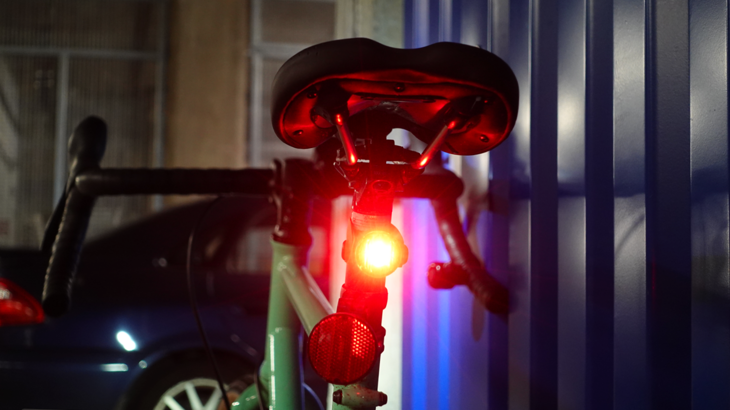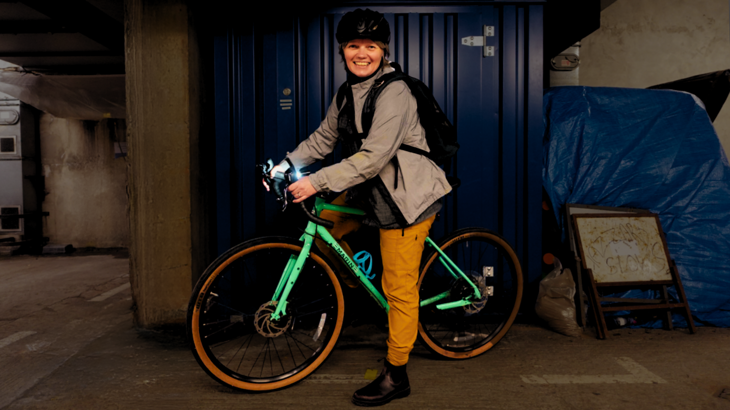When the nights draw in, commuting on your bike might mean cycling in the dark. But don’t let that stop you from getting in the saddle. In this blog, we’ll show you how you can prepare for cycling once the sun has gone down, so you’ll feel safe and confident to cycle throughout the winter.

In this blog we’ll show you how you can prepare for cycling once the sun has gone down. Credit: Sustrans
Here are some top tips to help keep you pedalling safely throughout autumn and winter and to make sure you're visible to other road users.
Is it a legal requirement to have lights on your bike?
After months of riding your cycle without needing lights, you may be out of practice in ensuring you have your bike lights on you at all times.
In the UK there are legal minimum requirements for cycling between sunset and sunrise.
Make sure you have one front white light attached to your cycle, one rear red light, a red reflector at the back and four amber pedal reflectors.
You’ll need lights for cycling in the dark but it’s also a good idea to turn them on if it’s foggy or particularly dark during the daytime.
Consider putting your rear light where it can always be seen, like attaching a permanent LED light to your pannier rack.
However, if your lights are easily removable, take them with you when you lock your bike up and head inside.
It may also be worth keeping a backup set of lights at work and a spare set of batteries.
There are also many USB charged lights available, so you can charge them while you’re at your desk.

Bike lights at nighttime are a legal requirement in the UK. Credit: Emily Wilson
Light the way
Depending on where you’re cycling, you might also need your lights to help you see where you’re going.
Make sure they’re bright enough to light up the way, and gently angle the beam downwards at the road ahead, at an angle of around 3.5 degrees. This means you can see where you’re going but won’t blind oncoming traffic.
The beam on the road also helps oncoming traffic see how far away you are, in contrast to a horizontal light which is harder to gauge.
Be bright and stand out
Being seen by other road users is vital when riding at night.
Wearing brightly coloured reflective clothing is a good way to stand out on dark, rainy, or foggy days. You can get reflective jackets to ensure you’re seen in the dark, or reflective accessories to attach to yourself or your bag.
There are many accessories for both you and your bike that will make you more visible to other road users, including reflective belts, wheel lights and reflective strips.
Plan and know your route
As the seasons change, it may be a good time to consider changing your regular routes to a better lit path or road.
Some routes might include seasonal hazards such as fallen leaves and branches or icy patches.
To make sure you don’t get lost on a new route, test it out in the daytime to build up your confidence and familiarity with it.

A reflective jacket can be a great way to make sure you're visible to other road users. Credit: Emily Wilson
Keep your bike in good shape
Making sure your bike is in the best working order it can be will greatly reduce your chances of experiencing problems while on the road.
Fixing your cycle on the roadside is a challenge and is even more difficult in the dark.
To avoid getting punctures, fit winter tyres to your bike and pump them up regularly.
Get in the habit of checking your bike regularly – simple checks and maintenance can help you enjoy hassle-free riding and avoid repairs. The M check is a simple way to make sure your bike is safe to ride.
Avoid cycling in the gutter as this is where most puncture-causing hazards can be found (broken glass and other debris).
Our range of bike maintenance products is perfect for everyday cycling and long-distance rides.
Be alert
It’s always important to be aware of your surroundings when cycling and even more so in the dark.
These tips should help you be seen by other road users. Staying alert to what is happening around you will minimise any other risks.
Go slower than you would in the daytime and keep your eyes peeled for unexpected obstacles, bumps in the road and movement by others on the road or path.
Don’t let the dark put you off cycling throughout the winter.
As always, be safe but enjoy yourself. Riding on roads can be extra intimidating in the dark, but the more you get into the habit of doing it, the more you’ll build your confidence up.







